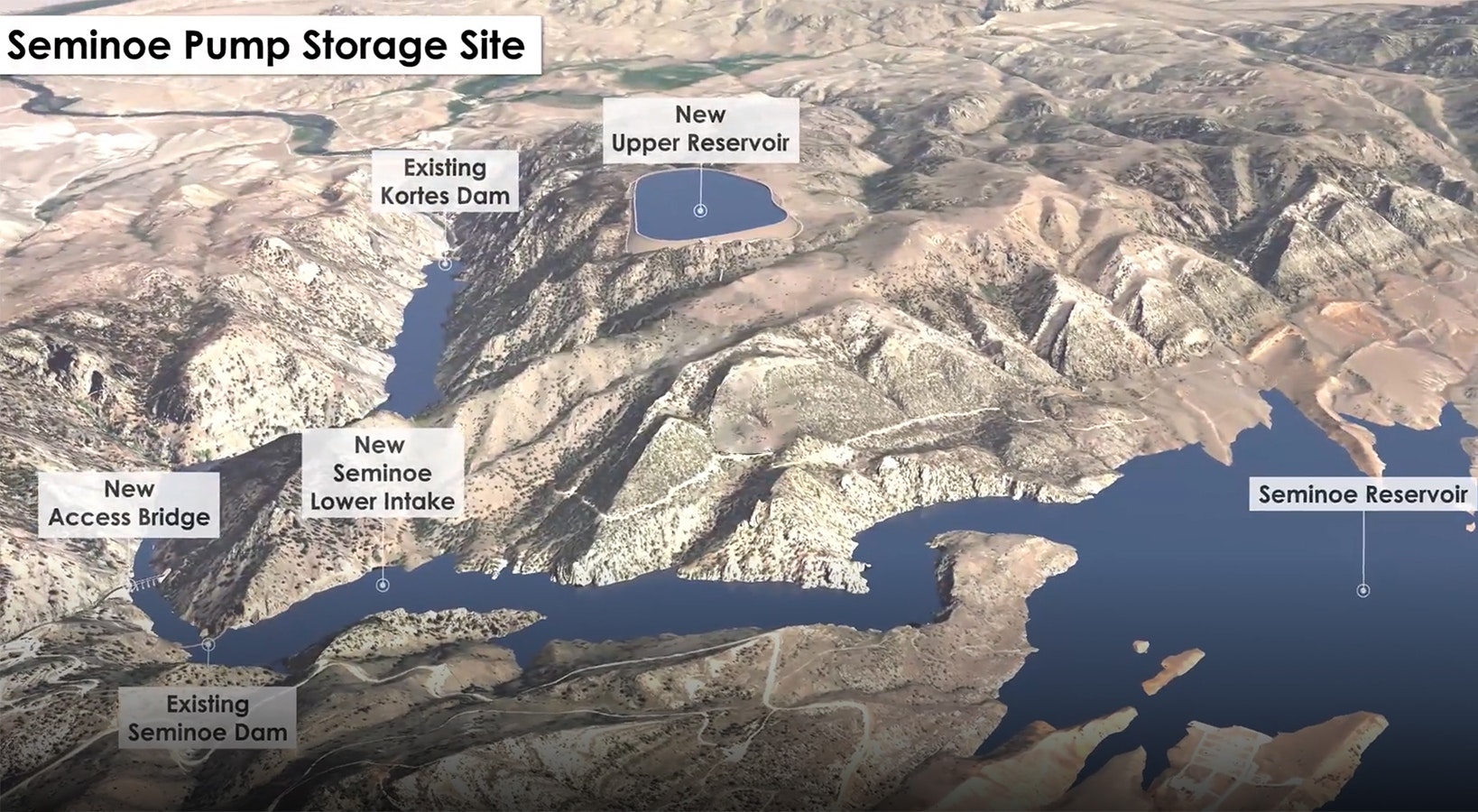A proposed pumped storage facility 35 miles northeast of Rawlins will supply 900 megawatts of electricity for up to 10 hours.
For comparison, the Dave Jonston coal-fired power plant near Glenrock has a capacity of 816 megawatts, though it operates almost continuously.
The project developers, rPlus Energies, submitted their final license in January and Lars Dorr, the company’s project manager, told Cowboy State Daily that there are only about six United States pumped storage projects in the last 30 years that have hit that milestone.
Optimistic
These kinds of projects are enormous, require a lot of capital investment and take a long time to permit and build. Dorr said the company is optimistic its Seminoe project will get through the federal, state and local permitting challenges and be completed within a decade.
“We do generally have pretty good support on this project. It doesn’t appear that there’s a lot of opposition,” he said. “There are some challenges, and we’re working with various federal and state agencies to work through those challenges.”
What Is Pumped Storage?
Storage capacity is gaining attention as more intermittent wind and solar farms are added to the power grid. Since wind and solar only produce electricity with the right weather conditions, there can be long stretches — sometimes a week or longer — in which they don’t supply any power at all.
Storage capacity may help smooth out some of that down time, and the main forms of storage being pursued are batteries and pumped storage.
There are 42 pumped storage plants in the U.S. Almost all were built to shift energy produced by nuclear and coal-fired power plants at night to daytime use as a means to replace oil-based electrical generation.
Pumped storage is a form of hydroelectric generation. The facilities have two reservoirs, one placed at a much higher elevation than the lower reservoir.
The system uses electricity to pump water up to the higher reservoir. Then, when power is needed, the water is drained through pipes. The flowing water turns generators, which create power.
Advantages
Pumped storage has some advantages over battery facilities, which are very expensive and potentially dangerous.
One is lifespan.
Battery facilities last 10 to 20 years, while Dorr said the Seminoe Pumped Storage facility will last somewhere between 50 and 100 years.
There are about 150 pumped storage facilities in the world, and Dorr said he’s aware of only one that’s been retired. That facility used salt water, which is corrosive. All the rest are still in operation.
The Seminoe facility “could go beyond 100 years,” Dorr said.
Batteries supply energy for a few hours, whereas Seminoe will last up to 10.
Luigi Resta, CEO of rPlus Energies, told Cowboy State Daily there’s no degradation over time with the facility. So, it will produce 900 megawatts of power on its first day of operation as it will 50 years later. That long-term investment, Resta said, is better for ratepayers and utilities.
“When you look at that and compare it against batteries that need to have constant augmentation added every year to keep the same amount of capacity, pumped storage is definitely a much better investment,” Resta said.
Disadvantages
There is no perfect solution to the problem of intermittency with wind and solar, and pumped storage has some disadvantages compared to batteries.
Pumped storage facilities require larger investments up front, and since they require elevation, they don’t work in areas with flat terrain.
They also take up a lot of land. The Seminoe facility is still in the design and planning phase, so the exact amount of land hasn’t been determined.
It’s an open-loop facility, meaning that it’s connected to a natural body of water — the Seminoe Reservoir. After it’s built, the facility will pump water from the reservoir up to another reservoir 1,000 feet higher in elevation.
Pumped storage facilities also use a lot more water than a battery facility. The Seminoe Pumped Storage facility will require a one-time 10,000-acre-foot fill.
An acre foot is the amount of water it would take to put 1 acre of land under 1 foot of water. That means the Seminoe facility’s one-time fill is 3.26 billion gallons. After that, it will use less than 100 million gallons per year.
It also will require a 30-mile transmission line to connect to the Aeolus Substation near Medicine Bow.
Critical Component
Dorr said the Seminoe location was first scoped out as a possible site for pumped storage as far back as the 1980s. He said facilities like Seminoe are going to play an important role in the buildout of wind energy in the West.
PacifiCorp owns about 2,250 megawatts of wind generation across multiple facilities and is planning to increase that to 12,000 megawatts in just 27 years. That’s enough to power 3.6 million homes when the wind is blowing. People and businesses, however, need energy regardless of how much wind is blowing.
“In order to maintain a reliable and secure grid, energy storage is a really critical component to being able to dispatch energy,” Dorr said.
Jobs And Tax Revenue
Dorr and Resta said the state has been very supportive of the project, and the federal government has been facilitating the plan.
They expect to begin more outreach as plans come into focus and approvals begin rolling in.
When construction gets underway, which is expected to be around 2030, it will create 300 to 500 jobs over a four- to five-year period. The plant will then require up to 35 full-time jobs. It will generate an estimated $9 million in property taxes annually, with another $40 million to $60 million in sales tax revenue.
“Wyoming is really a leader in energy, and this will diversify the state’s portfolio,” Dorr said.





